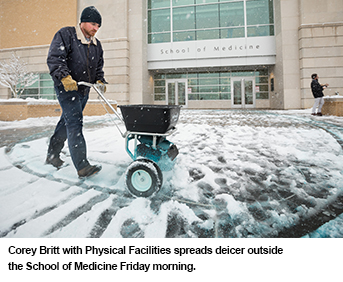Attaining Service Excellence
Good morning!
 We woke up to a wintry wonderland today, and isn’t it beautiful! The snowfall was a little more than predicted, but thankfully it has been mostly fluffy and not icy. Although the roads are in pretty good shape, the closing of daycare and schools puts pressure on our families, so we have to scramble fill some holes in our staffing. In these situations, we ask you to use your best judgment about traveling to ensure your personal safety, but the Medical Center does not close. I want to especially thank our grounds and maintenance staff for being here early this morning to clear the walks and entrances and to our nutrition staff for keeping our employees, students, patients and visitors fed and fueled with coffee.
We woke up to a wintry wonderland today, and isn’t it beautiful! The snowfall was a little more than predicted, but thankfully it has been mostly fluffy and not icy. Although the roads are in pretty good shape, the closing of daycare and schools puts pressure on our families, so we have to scramble fill some holes in our staffing. In these situations, we ask you to use your best judgment about traveling to ensure your personal safety, but the Medical Center does not close. I want to especially thank our grounds and maintenance staff for being here early this morning to clear the walks and entrances and to our nutrition staff for keeping our employees, students, patients and visitors fed and fueled with coffee.
Now, on to the topic of the day.
Lately I’ve been thinking about the importance of excellent customer service and how that makes a difference in the way an organization is perceived.
A few organizations do customer service very well. Most are unremarkable. Some are downright awful, and they don’t stay around very long.
On the other hand, at places like Disney and Nordstrom, service excellence is deeply imbedded in the culture. Their employees are extensively trained and the customer experience is designed to be exceptional.
There are a few simple things that employees of these companies do consistently well, like engaging customers. At Chick-Fil-A, for example, you will hear, “My pleasure.” A simple phrase consistently applied. (And much better than, “no problem.”)
To be exemplary, we have to do more. In our world of health care, that means expressing to patients and each other that we care.
How do we do that? We smile. We greet each other in the hall. We take an extra 30 seconds and ask if there is anything else we can do.
Back in my ER days, I would pause on my way out of a room and ask patients if they needed anything else. The most common answer was, “a blanket.” I would often say to colleagues, “I’m the best blanket-getter at the Medical Center!” Strictly speaking, this was not my job; it was not what I was paid to do. But I was glad to do it. A warm blanket goes a long way toward providing comfort in an unfamiliar setting. And that’s all the more reason it made a positive impression on a patient.
Caring about our patients and each other at this level is relatively easy. I think many people who work here do a good job with this, and that makes me proud to work here. Thank you.
Much harder is helping patients and families navigate our fragmented health care system (although it’s more like a set of unconnected systems). When modern health care processes were designed, patients and their convenience were not the top consideration.
Think about it. Most of the components along the continuum of care – doctor’s offices, hospitals, rehab centers, nursing homes, etc. – operate independently of each other. Completely separate from these providers are the insurance companies that pay for much of the care, including government payers. And that’s not even considering a universe of suppliers and consultants who have little connection to each other or their customers.
It’s not coordinated, often messy, and for the most part, we leave it to patients and their families to make sense of it all.
At UMMC, we have the advantage of being in an integrated structure, with hospitals and providers working as part of the same organization. Unfortunately, we still operate largely along traditional departmental/specialty lines, creating disconnects that can sometimes leave patients inconvenienced.
That’s why I’m excited and hopeful about our new service line initiatives. Beginning early next year, we will be doing what Disney and all great companies do – designing our services around the needs and expectations of the customer, or in our case, the patient.
What will that look like? Well, instead of making multiple visits for tests and appointments with several providers, patients will be scheduled for one visit in which we’ll try to accommodate all of their needs. That will be the goal.
Sounds simple, but when you’ve operated this way for as long as we have - largely for our own convenience rather than our patients’ - this will take some time to perfect. We’ll be piloting this approach in a few disciplines and gradually spreading it to others. I’m grateful to Liz Youngblood, adult services CEO, Dr. Scott Stringer, physician executive for the Council of Clinical Chairs, and others for leading this charge.
Implementing service lines will be one giant step toward enhancing our service excellence culture at UMMC. That’s important, because all the evidence suggests that health care organizations that provide a superb patient experience will thrive in the future. Bringing us that much closer to our goal of A Healthier Mississippi.



